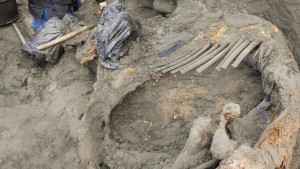Jan 15 2016
Arctic Humans 45,000 Years Ago
 The dating of phenomena in the past, such as the existence of a specific species of animal or the presence of humans, is always based upon the earliest and latest evidence discovered so far. When you think about it, it is obviously very unlikely that we will have discovered the absolute earliest or latest occurrence of anything in the past.
The dating of phenomena in the past, such as the existence of a specific species of animal or the presence of humans, is always based upon the earliest and latest evidence discovered so far. When you think about it, it is obviously very unlikely that we will have discovered the absolute earliest or latest occurrence of anything in the past.
It it therefore very common for new discoveries of fossils or archaeological evidence to increase the range of a phenomenon. Date ranges are always tentative and changing, although new discoveries still often lead to headlines emphasizing how surprised scientists were at the find.
For example, when did humans first live in the Arctic circle? There are essentially three types of evidence for a human presence. The first is direct evidence – human fossils found in the location and dated to a specific time. The second is human artifacts, stone tools being the most common because they preserve well and are unambiguous human artifacts. The third is human activity, such as fire pits or butchered animals.
Researchers have recently examined new evidence of the third kind – the remains of a a mammoth in the Arctic with clear evidence of damage done by human hunters. The discovery was made in 2012 by an 11-year old Russian boy in Yenisei Bay, within the Arctic circle 2000 kilometers from the North Pole.
The previous oldest evidence of humans in the article were beads and stone tools dated to 35,000 years ago. This find therefore pushes the date back 10,000 years to 45,000 years.
The oldest human fossil in the area also dates to about 45,000 years ago, a thigh bone from Siberia, but this is sub-arctic (although nearby). Clearly humans were venturing far north, and were adapted to the very cold weather. Scientists speculate that big game, such as the mammoth, is what lured early humans into the arctic.
The new find shows clear evidence of damage done by weapons such as spears. Science reports:
“One can almost see the blow-by-blow battle between people and mammoth fought on those frozen plains,” says Curtis Marean, a paleoanthropologist at Arizona State University, Tempe, who was not involved with the study. “The impact wounds on the bones with embedded stone fragments is conclusive evidence that people slayed this mammoth.”
Scientists still remain cautious, as they should. The carbon dating of preserved collagen dates to 45,000 old, but the scientists want independent verification to rule out contamination, because of the importance of the date.
Conclusion
Bit by bit scientists are filling in the story of exactly when and where humans spread throughout the world. One specific question is when (and perhaps how many times) did humans cross from Siberia to North America?
There is now clear evidence that humans were hunting in the Arctic 45,000 years ago. The oldest evidence for humans on the North American side of the Arctic are the bones of a buried 3-year old child in Alaska from 11,500 years ago. However, there is DNA evidence of humans farther south dating to 14,500 years ago.
Evidence for earlier human occupation are currently controversial.
It is likely, however, that our current dates for the earliest humans in the Americas will be pushed back. We now know humans were in the Arctic on the Siberia side 45,000 years ago. The Bering land bridge was probably open 11,000 years ago, 18,000 years ago, and prior to 35,000 years ago. The question is – when did humans first cross, and did they cross multiple times?
We’ll just have to wait and see what new discoveries tell us.






